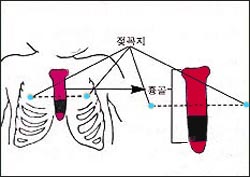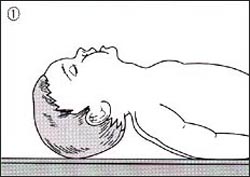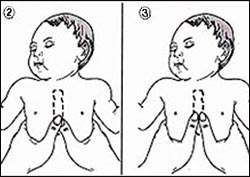신생아 기본 심폐 소생술 처치법을 사진으로 설명하면, Neonatal cardiopulmonary resuscitation
신생아 기본 심폐 소생술
신생아 기본 심폐 소생술은 영유들이나 학령기 아이들 또는 사춘기 아이들 위한 기본 심폐 소생술과 다른 점이 많다.
|
참고로, 미국에서는 신생아의 건강과 질병을 다루는 모든 의료직에 종사하는 소아청소년과 개업의 및 병원 내에서 신생아 진료를 하는 미 소아청소년과 의사들은 신생아 심폐 소생술 처치법학을 매 2년마다 연수해야하고 신생아 심폐 소생술 처치법 실기 시험과 필기시험에 합격해야 해당 병원 내에서 신생 질병 및 건강관리를 할 수 있는 자격과 권한을 부여받는 것이 보통이다. |
신생아 기본 심폐 소생술을 사진으로 설명하면

▴ 그림 1-46. 1. 신생아 기본 심폐 소생술을 할 때 검은 색으로 표시된 흉골 부위를 그림 271에서 볼 수 있는 것과 같이 엄지손가락으로 눌러 심장 마사지를 한다. 출처; Textbook of Neonatal Resuscitation. 1987과 소아가정간호백과

▴ 그림 1-47. 2. 갓 태어난 신생아 기본 심폐 소생술을 할 때 단단하고 편평한 자리에 등을 대고 눕힌다. 목을 뒤로 살짝 젖혀 기도가 더 잘 열리게 한다. 출처; Textbook of Neonatal Resuscitation. 1987과 소아가정간호백과

▴ 그림 1-48. 신생아의 흉골의 아래 부위에 양쪽 엄지손가락을 그림 ②과 같이 겹쳐놓거나 그림 ③과 같이 나란히 올려놓고 나머지 손가락으로 아기의 몸통을 싸잡고 심장 마사지를 한다. 출처;Textbook of Neonatal Resuscitation. 1987과 소아가정간호백과

▴ 그림 1-49. 집게손가락과 가운데 손가락의 끝 부분을 그림 ④과 같이 흉골 아래 부위에 올려놓고 신생아의 앞가슴을 등뼈가 있는 쪽을 향해 눌러 심장 마사지를 한다. 출처;Textbook of Neonatal Resuscitation. 1987과 소아가정간호백과

▴ 그림 1-50. 처치자의 한쪽 손으로 신생아의 등을 받치고 다른 쪽 손으로 그림⑤와 같이 심장 마사지를 할 수 있다. 출처; Textbook of Neonatal Resuscitation. 1987과 소아가정간호백과

▴ 그림 1-51. 심장 마사지를 할 때 그림 273과 같이 등뼈를 향하여 앞가슴을 수직으로 눌러서 심장 마사지를 한다.
그림 274의 좌와 같이 앞가슴을 눌러서는 안 된다
심장 마사지를 할 때는 인공호흡을 항상 동시에 해야 한다. 출처; Used with permission from Textbook of Neonatal Resuscitation. 1987과 소아가정간호백과
-
신생아가 갑자기 숨을 거의 쉬지 못하거나 전혀 쉬지 않을 때나 심장이 아주 비정상적으로 느리게 뛰거나 멈춘 후 바로 인공호흡과 심장 마사지를 통해 기본 신생아 심폐 소생술 또는 전문 신생아 심폐 소생술을 해야 한다(p.00 신생아 심폐 소생술 참조).
-
우선 앞가슴이나 복부가 숨 쉴 때처럼 위쪽으로 올라갔다 내려갔다 움직이나 확인하고 처치자의 귀를 신생아의 입과 코에 대서 숨소리가 나나 또 숨이 뺨에 닿나 체크해본다.
-
숨을 쉬지 않으면 기도를 열어 준다.
-
구강, 콧구멍 속, 인두강 속에 있는 분비물, 구토 물, 가래, 이물 등을 손가락으로 후비어 내든지 흡입구 등으로 흡입해서 제거해서 공기가 기도 속으로 잘 통과하도록 한다.
-
그와 동시에, 손목, 팔꿈치 앞 부위, 서혜부, 목 등에서 맥박이 뛰는지 알아본다.
-
심장이나 맥박이 비정상적으로 아주 느리게 뛰거나, 아주 뛰지 않을 때는 인공호흡과 심장 마사지를 동시 시작한다.
-
그렇지만 신생아가 숨을 못 쉬거나 숨을 쉬지 않을 때 맥박이나 심장 박동이 정상인지 비정상인지 알아보기가 힘들기 때문에 숨을 거의 쉬지 못하거나 숨을 전혀 쉬지 못하면 인공호흡과 심장 마사지를 동시 하는 것이 보통이다.
-
심장 마사지를 하는 방법은 나이와 여러 가지 조건에 따라 조금씩 다르다. 갓 낳은 아기나 영아에게는 다음과 같이 심장 마사지를 한다.
-
갓 낳은 신생아나 영아를 단단하고 편평한 자리에 등을 대고 눕힌다(신생아의 심폐 소생술 그림 ① 참조).
-
처치자의 한쪽 엄지손가락의 끝 부분을 아기의 흉골 아래 ⅓ 부위에 올려놓은 후, 그 엄지손가락의 끝 부분의 위에다 다른 쪽의 엄지손가락의 끝 부분을 올려놓든지(신생아의 심폐 소생술 그림 ②),
-
양쪽 엄지손가락의 끝 부분을 흉골의 아래 ⅓ 부분에 나란히 올려놓는다(신생아의 심폐 소생술 그림 ③). 나머지 양쪽 손의 손가락들과 손바닥으로 아기의 몸통을 싸잡고 심장 마사지를 하든지,
-
한쪽 손의 집게손가락과 가운데 손가락의 끝 부분은 흉골의 아래 ⅓ 부분에 올려놓고 등뼈를 향하여 가슴을 ½∼¾인치(신생아 경우)를, 1~1.5인치(1~8세 아이 경우)를 눌러 좌심실 내 혈액이 대 동맥 혈관을 통과해 전신으로 흘러가도록 심장 마사지를 효율적으로 한다(p.00 신생아의 심폐 소생술 그림 ④).
-
심장 마사지를 신생아에게 할 때는 1분에 100회 한다. 심장 마사지를 3번 한 후 인공호흡을 한 번 한다.
-
-
1∼8세 유아나 학령기 아이나 8세 이상 학령기 아이나 사춘기 아이에게 심장 마사지를 할 때는 심장 마사지를 하는 처치자의 한쪽 손바닥이나 양쪽 손바닥을 환아의 흉골의 중간 부분의 바로 아래 부분에 올려놓고 1분에 100번 정도 한다.
-
2∼2.5초 동안 ‘하나‘라고 소리 내어 세면서 첫 번째 심장 마사지를 해 주고, “둘”이라고 소리 내어 세면서 두 번째 심장 마사지를 하고, “셋” 하고 소리를 내면서 세 번째 심장 마사지를 하고, 바로 그 다음에는 인공호흡을 한 번 한다.
-
그 다음 또다시 같은 요령으로 2∼2.5초 동안에 “하나, 둘, 셋”을 전과 같이 세면서 앞에서와 같이 심장 마사지를 연달아 3번 하고 인공호흡을 한 번 한다.
-
두 사람 이상 처치자가 있을 때는 한 사람은 인공호흡을, 다른 사람은 심장 마사지를 한다. 그렇지만 한 사람만 있을 때는,한 사람이 인공호흡도 하고 심장 마사지를 해 주면서 다른 사람의 도움을 청한다.
-
Neonatal cardiopulmonary resuscitation, 신생아 기본 심폐 소생술 처치법을 사진으로 설명하면
With pictures describing basic CPR treatment for newborns
- Basic CPR for newborns
- Basic CPR for newborns differs from basic CPR for infants, school-aged or adolescent children.
- For reference, in the United States, pediatric and adolescent practitioners in all medical professions dealing with neonatal health and illness, and U.S. pediatricians and doctors who treat newborns in hospitals, are required to study neonatal CPR every two years.
- It is common to receive qualifications and authority to manage newborn diseases and health in the hospital only after passing the CPR treatment practice test and written test.
The basic CPR in newborn babies with pictures,

▴ Figure 1-46. 1. When performing basic cardiopulmonary resuscitation for newborn babies, do a heart massage by pressing the sternum area marked in black with your thumb as shown in Figure 271. Source; Textbook of Neonatal Resuscitation. Lesson 1987 Pediatric and Family Nursing Encyclopedia

▴ Figure 1-47. 2. When performing basic cardiopulmonary resuscitation for newborn babies, lay your back on a hard, flat surface. Tilt your newborn’s neck back slightly to open the airways better. source; Textbook of Neonatal Resuscitation. Lesson 1987 Pediatric and Family Nursing Encyclopedia

▴ Figure 1-48. Put your both thumbs on the lower part of the newborn’s sternum as shown in Figure ② or put them side by side as shown in Figure ③ and wrap the baby’s torso with your remaining fingers and massage the heart. Source; Textbook of Neonatal Resuscitation. Lesson 1987 Pediatric and Family Nursing Encyclopedia

▴ Figure 1-49. Place the tip of the index finger and middle finger on the lower part of the newborn’s sternum as shown in Figure ④, and press the newborn’s forearm toward the side of the spine to perform a heart massage. Source; Textbook of Neonatal Resuscitation. Lesson 1987 Pediatric and Family Nursing Encyclopedia

▴ Figure 1-50. One hand of the caregiver can support the newborn’s back, and the other hand can do a heart massage as shown in Figure ⑤. Source; Textbook of Neonatal Resuscitation. Lesson 1987 Pediatric and Family Nursing Encyclopedia

▴ Figure 1-51. When performing a heart massage, do a heart massage by pressing the forearm vertically toward the spine as shown in Figure 273. Do not press the front chest as shown on the left in Figure 274.
- When doing heart massage, artificial respiration should always be done at the same time. Source; Used with permission from Textbook of Neonatal Resuscitation.
- Lesson 1987 Pediatric and Family Nursing Encyclopedia Basic neonatal cardiopulmonary resuscitation or specialized neonatal cardiopulmonary resuscitation should be performed immediately after a newborn baby suddenly has little or no breathing, or the heart beats or stops very abnormally slowly (newborn baby cardiopulmonary resuscitation) through artificial respiration and heart massage (p. Reference).
- First of all, check whether the front chest or abdomen moves upwards and downwards, like when breathing, and check if the patient’s ears are placed on the newborn’s mouth and nose to see if there is a sound of breathing, or if the breath is touching the cheeks. If your child doesn’t breathe, it opens your child’s airways.
- The secretions, vomiting water, phlegm, foreign body, etc. in the mouth, nostrils, or pharyngeal cavity are smearing out with a finger or using suction to remove vomitus in airways.
- At the same time, check if the pulse is beating on the wrist, the front of the elbow, the groin, and the neck.
- When the heart or pulse is beating abnormally very slowly or not beating very much, start artificial respiration and heart massage at the same time.
- However, since it is difficult to determine whether a newborn’s breathing or not breathing, whether the pulse or heart rate is normal or abnormal, it is common to perform artificial respiration and heart massage at the same time if he or she can hardly breathe or breathe at all.
- The method of doing a heart massage varies slightly depending on your child’s age and various conditions.
- For a newborn baby or infant, do a heart massage as follows. Lay a newborn baby or infant on their back on a firm and flat surface (refer to the picture of CPR for newborn infants).
- After placing the tip of one thumb of the person on the baby’s sternum under the sternum and then placing the tip of the other thumb on top of the tip of the thumb (CPR picture ② for newborn infants),
- Place the ends of both thumbs side by side on the lower part of the sternum (CPR picture for newborn infants ③). Wrap the baby’s torso with the fingers and palms of both hands and do a heart massage,
- Place the tip of the forefinger and middle finger of one hand on the lower part of the sternum and press ½ to ¾ inch (for newborn babies) and 1 to 1.5 inch (for children 1-8 years old) toward the spine to the left ventricle.
- Efficient cardiac massage so that your child’s blood passes through the aortic vessels and flows to the whole body (CPR picture for newborn babies ④).
- When doing heart massage to a newborn baby, do it 100 times per minute.
- After three heart massages, give artificial respiration once.
- When performing a heart massage to an infant or school-age child aged 1 to 8, or a school-age child or adolescent child over the age of 8, place one or both palms of the person performing the cardiac massage on the middle part of the child’s sternum and place it under the middle of the child’s sternum and place it at 100 per minute.
- Do it about once. For 2 to 2.5 seconds, do the first heart massage while counting out’one’, do a second heart massage while counting out loud “two”, and do a third heart massage while making a sound “three”
- Next, do one artificial respiration.
- Then, again with the same technique, count “one, two, three” as before for 2 to 2.5 seconds, do heart massage 3 times in succession as before, and artificial respiration once.
- When more than one person is present, one person will give artificial respiration and the other will have a heart massage.
- However, when there is only one person, one person does artificial respiration, gives a heart massage, and asks for help from another person.
출처 및 참조 문헌 Sources and references
- NelsonTextbook of Pediatrics 22ND Ed
- The Harriet Lane Handbook 22ND Ed
- Growth and development of the children
- Red Book 32nd Ed 2021-2024
- Neonatal Resuscitation, American Academy Pediatrics
Emergency Medical Service for Children, By Ross Lab. May 1989. p.10
Emergency care, Harvey grant, and Robert Murray
Emergency Care Transportation of Sick and Injured American Academy of Orthopaedic Surgeons
Emergency Pediatrics A Guide to Ambulatory Care, Roger M. Barkin, Peter Rosen
Quick Reference To Pediatric Emergencies, Delmer J. Pascoe, M.D., Moses Grossman, M.D. with 26 contributors
Manual of Emergency Care 응급환자관리 정담미디어
소아가정간호백과-부모도 반의사가 되어야 한다, 이상원 저
The pregnancy Bible. By Joan stone, MD. Keith Eddleman, MD
Preparation for Birth. Berverly Savage and Dianna Smith
임신에서 신생아 돌보기까지. 이상원
Breastfeeding. by Ruth Lawrence and Robert Lawrence
Nelson Textbook of Pediatrics 14th ed. Beherman,
The Johns Hopkins Hospital, The Harriet Lane Handbook, 18th edition
Red book 29th-31st Ed 2021
Nelson Text Book of Pediatrics 19th-21st Edition
Infectious disease of children, Saul Krugman, Samuel L Katz, Ann A. Gerhon, Catherine Wilfert
The Harriet Lane Handbook 19th Edition
Growth and Development of Children, George H. Lowrey 8th edition
소아과학 대한교과서
제1권 소아청소년 응급의료 참조문헌과 출처
Other
Copyright ⓒ 2015 John Sangwon Lee, MD., FAAP
“부모도 반의사가 되어야 한다”-내용은 여러분들의 의사로부터 얻은 정보와 진료를 대신할 수 없습니다.
“The information contained in this publication should not be used as a substitute for the medical care and advice of your doctor. There may be variations in treatment that your doctor may recommend based on individual facts and circumstances. “Parental education is the best medicine.”